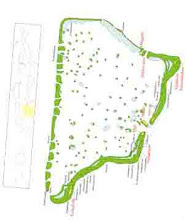
Our trip to Chile was almost in the end. A few days later and we will be starting our long way home. At 5 o’clock am, dark night, we star our journey. We left our comfortable hotel at San Pedro de Atacama and we jumped in to the frizzing “desert of the dead”. We skip in to the all road vehicle for the unknown tracks, but with a clear destination: the Geysers of El Tatio, a place located at 90km from San Pedro de Atacama, not fare from the Bolivian border. When we get in to the car, we had no idea what to find. The trip was long and rough, but we trusted our guide. El Tatio should be one of the most enchanting landscapes of Region, and why not of the north of the country. When we were arriving it was still dark and the place looked quite and unmoving. At that moment, it looked just a big plane with some frizzed water. We stopped the car, and we were advised not to touched the water because it will be very hot and danger. I was curious! In fact, at the moment of the sun rising, the unexpected happened. A strong noise came from the deep of the earth and strong Geysers and fumaroles emerge to the surface through fissures of the terrestrial bark, reaching a temperature of 85º C and about ten meters of height. This magnificent spectacle achieves its maximum expression during the first hours of the morning, between 6 and 7 o’clock in the morning hours, with temperatures below zero. After such a big trip, we were not expecting such an emotion. We had an extraordinary picnic breakfast on the spot after a big number of photos. These extremely low temperatures in addition to the large number of tourists, who arrived year after year to the zone, encouraged native people of the sector and authorities to count on a fully equipped tourism complex to properly receive thousands of national and foreign visitors that should be working today. We went back to the hotel in a different perspective, at day light, crossing fields of wild cactus and a volcano into the horizon. The temperature was warming up, and we started taking some lairs of clothes and filling the desert sun in our bodies.
















